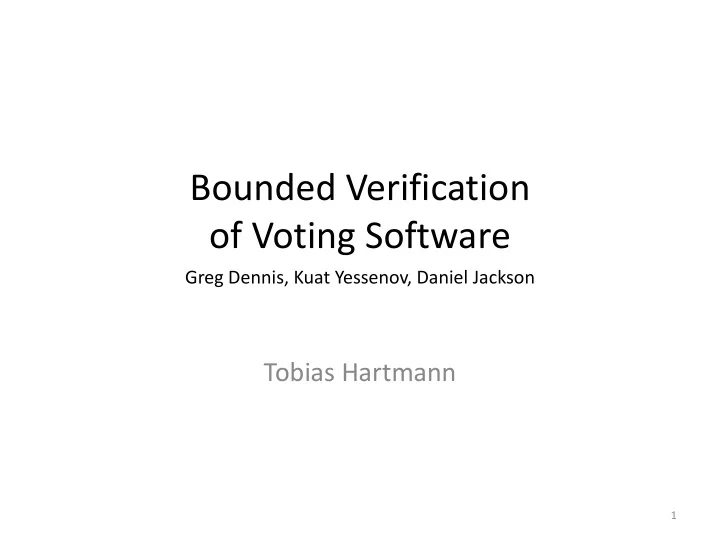

Bounded Verification of Voting Software Greg Dennis, Kuat Yessenov, Daniel Jackson Tobias Hartmann 1
2 2011, www.e-voting.cc
Electronic voting machines • Used in the Netherlands since 1998 • Introduced KOA Remote Voting System in 2004 – Internet voting application – Java, Open-Source (GPL) – Main part implemented by LogicaCMG • Security of Systems (SoS) research group developed independent tally subsystem 3
The Problem • How to verify that the software is correct? – Electoral systems are highly complex • Vote-tallying subsystem of KOA – Formally specified using Java Modeling Language (JML) – Core partially verified using Extended Static Checker for Java, ESC/Java2 (47%) – Boundary unit tests generated using jmlunit (8000) – 100% coverage not possible in timeframe of project (4 weeks) 4
Bounded verification • Examine all executions of a procedure with bounded – Heap size – Number of loop unrollings • Under-approximation – Will find counterexample if in bounds – Will always miss bugs that require larger bounds • Relies on small-scope hypothesis – Many defects have small counterexamples 5
Original approach Java Code + Specification (JML) Relational first order logic (Alloy) Alloy Analyzer (SAT with external solver) 6
Forge Intermediate Representation (FIR) • Simple relational programming language – Supports modularity • Automatic Java-to-FIR translation – Relational view of the heap – Types as sets – Fields as functional relations – Local variables as singleton sets • Basically 3 tools: Forge , JMLForge and JForge 7
The Forge framework • From FIR procedure tool obtains – Constraint between pre-state s and post- state s’: P(s, s’) – User provided specification S(s, s’) • Combined to P ( s , s ' ) S ( s , s ' ) – True for executions that are possible but violate specification • Bounds on – Number of loop unrollings – Bitwidth of FIR integers – Scope for each domain 8
New approach: Three stage translation Java Code + Specification (JML) Forge Intermediate Representation (FIR) Kodkod relational logic Kodkod model finder (SAT with external solver) 9
Results • Tested 169 methods of 8 classes – Scope of 5, bitwidth of 4 (-8 to 7), 3 loop unrollings • 19 specification violations found – Overspecification, Underspecification or Bug – No false alarms • Minimum bound for each violation to be detected – Scope 2, bitwidth 3, 3 loop unrollings – Supports small-scope hypothesis 10
Example violation 1 class KiesLijst { public int compareTo(final Object an_object) { if (!(an_object instanceof KiesKring)) { throw new ClassCastException(); } final KiesKring k = (KiesKring) an_object; return number() - k.number(); } } • Unit-Testing did not catch the bug because parameter is of type Object instead of KiesLijst 11
Example violation 2 //@ requires a_kieskring_name.length() <= KIESKRING_NAME_MAX; //@ ensures number() == a_kieskring_number; //@ ensures name().equals(a_kieskring_name); private /*@ pure @*/ KiesKring(final byte a_kieskring_numer, final /*@ non_null @*/ String a_kieskring_name) { my_number = a_kieskring_number; my_name = a_kieskring_name; } //@ ensures \result.length() <= KIESKRING_NAME_MAX_LENGTH; /*@ pure non_null @*/ String name() { return my_name; } • Again missed by Unit-Testing. 12
Limitations • Translation from FIR to relational logic – Sound – Complete within bounds • Translation from Java to FIR – Not all Java statements supported and optimizations introduce imprecision – Spurious counterexamples: Integer overflow due to limited bitwidth – Missed counterexamples: No real number arithmetic 13
Conclusion and future work • Despite a verification-centric methodology 19 out of 169 methods violate specification • Benefits compared to unit testing • Future improvement of performance necessary • JMLForge not actively supported anymore, use JForge 14
References • Not very detailed and self-contained, had to read other papers as well – Greg Dennis, Felix Chang, Daniel Jackson. Modular Verification of Code with SAT – Joseph R. Kiniry, Alan E. Morkan, Dermot Cochran, Fintan Fairmichael, Patrice Chalin, Martijn Oostdijk, Engelbert Hubbers. The KOA Remote Voting System: A Summary of Work to Date – Divya Gopinath Scaling Scope Bounded Checking using Incremental Approaches – Kuat T. Yessenov A lightweight specification language for bounded program verification 15
FIR example class Birthday { /*@ non_null */ Month month; int day; //@ requires this.month.checkDay(d); //@ ensures this.day == d; void setDay(int d) { Month m = this.month; boolean dayOk = m.checkDay(d); if (dayOk) this.day = d; } } class Month { int maxDay; //@ ensures \result <==> (d > 0 && d <= maxDay); /*@ pure */ boolean checkDay(int d) { … } } 16
FIR example domain Birthday, domain Month, domain Object global month: Birthday -> Month global day: Birthday -> Integer global maxDay: Month -> Integer local this: Birthday, local d: Integer local m: Month, local dayOk: Boolean proc setDay (this, d): () m = this.month; dayOk = spec (dayOk (d > 0 AND d <= m.maxDay)); if dayOk then day = day (this -> d) else exit; 17
JForge Example • Eclipse Plugin, http://sdg.csail.mit.edu/forge/ • Uses JForge Specification Language (JFSL) 18
JForge Example 19
JForge Example 20
Recommend
More recommend